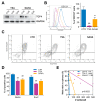Histone Deacetylase Inhibitors Impair Glioblastoma Cell Motility and Proliferation
- PMID: 35454804
- PMCID: PMC9027190
- DOI: 10.3390/cancers14081897
Histone Deacetylase Inhibitors Impair Glioblastoma Cell Motility and Proliferation
Abstract
Despite being subjected to high-dose chemo and radiotherapy, glioblastoma (GBM) patients still encounter almost inevitable relapse, due to the capability of tumor cells to disseminate and invade normal brain tissues. Moreover, the presence of a cancer stem cell (CSC) subpopulation, already demonstrated to better resist and evade treatments, further frustrates potential therapeutic approaches. In this context, we previously demonstrated that GBM is characterized by a tightly-regulated balance between the β-catenin cofactors TCF1 and TCF4, with high levels of TCF4 responsible for sustaining CSC in these tumors; thus, supporting their aggressive features. Since histone deacetylase inhibitors (HDI) have been reported to strongly reduce TCF4 levels in colon cancer cells, we hypothesized that they could also exert a similar therapeutic action in GBM. Here, we treated primary GBM cultures with Trichostatin-A and Vorinostat, demonstrating their ability to strongly suppress the Wnt-dependent pathways; thus, promoting CSC differentiation and concomitantly impairing GBM cell viability and proliferation. More interestingly, analysis of their molecular effects suggested a prominent HDI action against GBM cell motility/migration, which we demonstrated to rely on the inhibition of the RhoA-GTPase and interferon intracellular cascades. Our results suggest HDI as potential therapeutic agents in GBM, through their action on multiple cancer hallmarks.
Keywords: Wnt signaling; cell migration; glioblastoma; histone deacetylase inhibitors; interferon pathway.
Conflict of interest statement
The authors declare no conflict of interest.
Figures







Similar articles
-
HIF-1α/Wnt signaling-dependent control of gene transcription regulates neuronal differentiation of glioblastoma stem cells.Theranostics. 2019 Jul 9;9(17):4860-4877. doi: 10.7150/thno.35882. eCollection 2019. Theranostics. 2019. PMID: 31410187 Free PMC article.
-
Inhibition of LSD1 sensitizes glioblastoma cells to histone deacetylase inhibitors.Neuro Oncol. 2011 Aug;13(8):894-903. doi: 10.1093/neuonc/nor049. Epub 2011 Jun 8. Neuro Oncol. 2011. PMID: 21653597 Free PMC article.
-
The effects of histone deacetylase inhibitors on glioblastoma-derived stem cells.J Mol Neurosci. 2015 Jan;55(1):7-20. doi: 10.1007/s12031-014-0329-0. Epub 2014 May 30. J Mol Neurosci. 2015. PMID: 24874578
-
Advances in histone deacetylase inhibitors in targeting glioblastoma stem cells.Cancer Chemother Pharmacol. 2020 Aug;86(2):165-179. doi: 10.1007/s00280-020-04109-w. Epub 2020 Jul 7. Cancer Chemother Pharmacol. 2020. PMID: 32638092 Review.
-
Repurposed Biguanide Drugs in Glioblastoma Exert Antiproliferative Effects via the Inhibition of Intracellular Chloride Channel 1 Activity.Front Oncol. 2019 Mar 13;9:135. doi: 10.3389/fonc.2019.00135. eCollection 2019. Front Oncol. 2019. PMID: 30918838 Free PMC article. Review.
Cited by
-
Identification of mitophagy-related hub genes during the progression of spinal cord injury by integrated multinomial bioinformatics analysis.Biochem Biophys Rep. 2024 Feb 13;38:101654. doi: 10.1016/j.bbrep.2024.101654. eCollection 2024 Jul. Biochem Biophys Rep. 2024. PMID: 38375420 Free PMC article.
-
Preclinical and clinical advances to overcome hypoxia in glioblastoma multiforme.Cell Death Dis. 2024 Jul 13;15(7):503. doi: 10.1038/s41419-024-06904-2. Cell Death Dis. 2024. PMID: 39003252 Free PMC article. Review.
-
Use of microRNAs as Diagnostic, Prognostic, and Therapeutic Tools for Glioblastoma.Int J Mol Sci. 2024 Feb 20;25(5):2464. doi: 10.3390/ijms25052464. Int J Mol Sci. 2024. PMID: 38473710 Free PMC article. Review.
-
KRAS is a molecular determinant of platinum responsiveness in glioblastoma.BMC Cancer. 2024 Jan 15;24(1):77. doi: 10.1186/s12885-023-11758-6. BMC Cancer. 2024. PMID: 38225605 Free PMC article.
-
Glioblastoma Therapy: Past, Present and Future.Int J Mol Sci. 2024 Feb 21;25(5):2529. doi: 10.3390/ijms25052529. Int J Mol Sci. 2024. PMID: 38473776 Free PMC article. Review.
References
-
- Verhaak R.G., Hoadley K.A., Purdom E., Wang V., Qi Y., Wilkerson M.D., Miller C.R., Ding L., Golub T., Mesirov J.P., et al. Integrated genomic analysis identifies clinically relevant subtypes of glioblastoma characterized by abnormalities in PDGFRA, IDH1, EGFR, and NF1. Cancer Cell. 2010;17:98–110. doi: 10.1016/j.ccr.2009.12.020. - DOI - PMC - PubMed
-
- Marenco-Hillembrand L., Wijesekera O., Suarez-Meade P., Mampre D., Jackson C., Peterson J., Trifiletti D., Hammack J., Ortiz K., Lesser E., et al. Trends in glioblastoma: Outcomes over time and type of intervention: A systematic evidence based analysis. J. Neurooncol. 2020;147:297–307. doi: 10.1007/s11060-020-03451-6. - DOI - PubMed
-
- Stupp R., Hegi M.E., Mason W.P., van den Bent M.J., Taphoorn M.J., Janzer R.C., Ludwin S.K., Allgeier A., Fisher B., Belanger K., et al. Effects of radiotherapy with concomitant and adjuvant temozolomide versus radiotherapy alone on survival in glioblastoma in a randomised phase III study: 5-year analysis of the EORTC-NCIC trial. Lancet Oncol. 2009;10:459–466. doi: 10.1016/S1470-2045(09)70025-7. - DOI - PubMed
Grants and funding
LinkOut - more resources
Full Text Sources
Molecular Biology Databases
Research Materials

